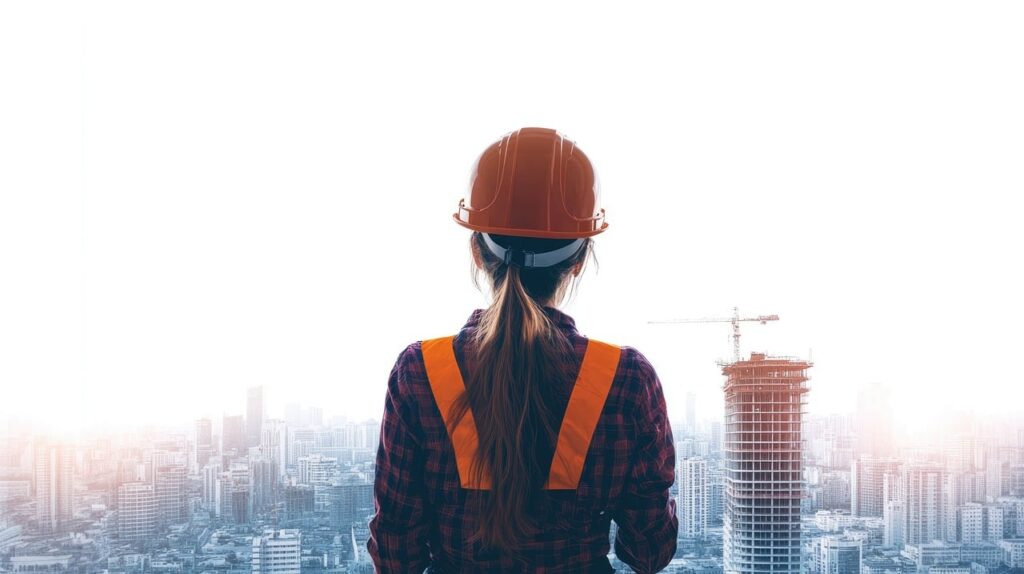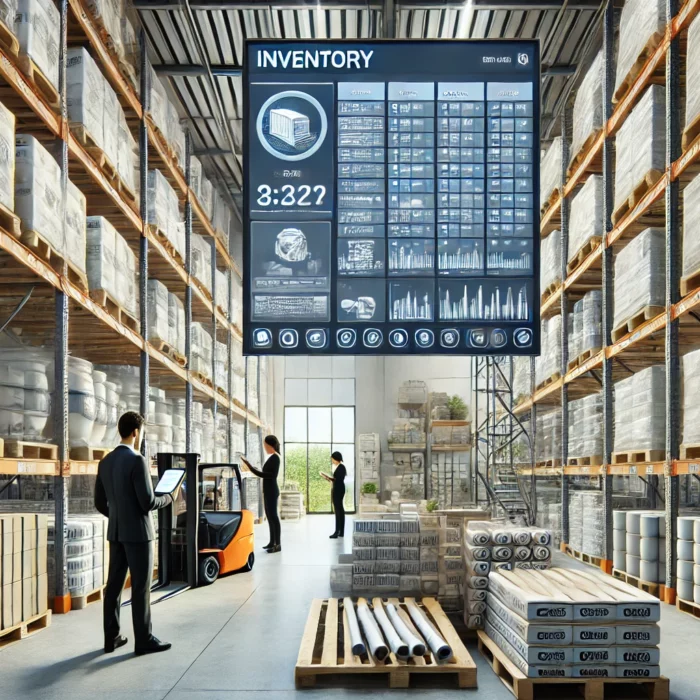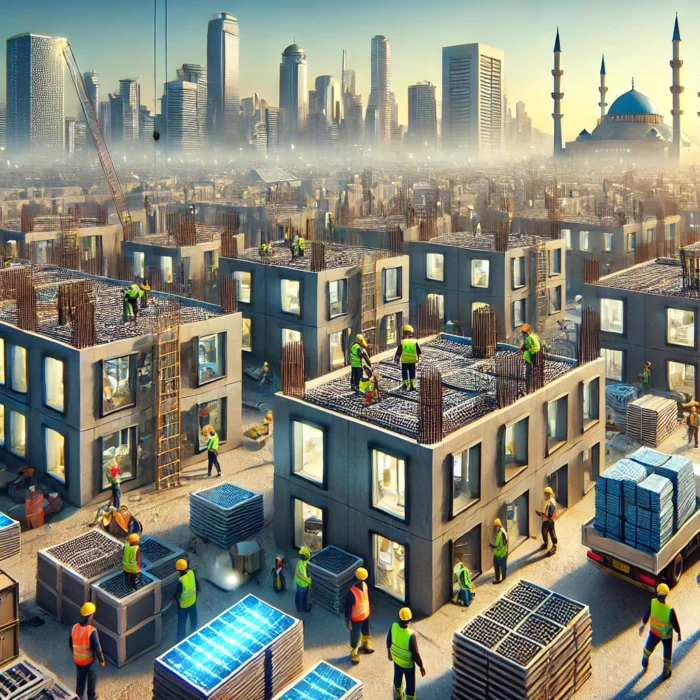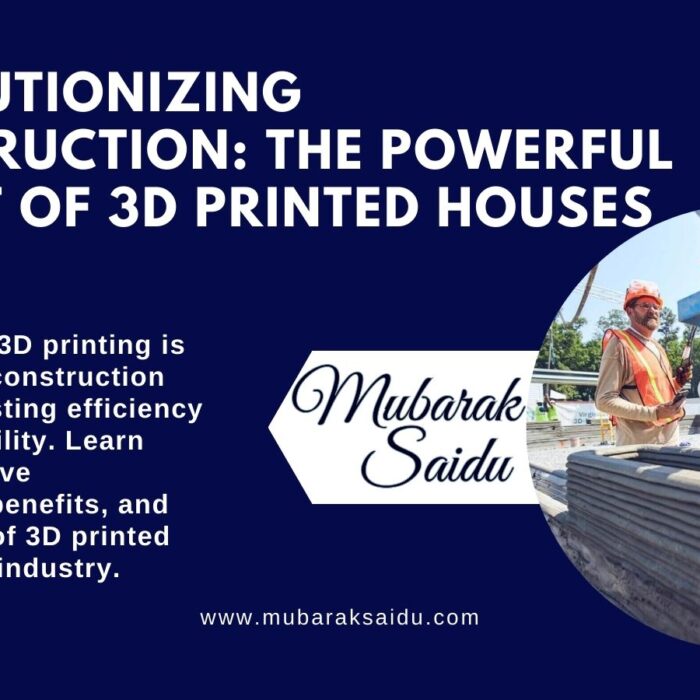
Hey there, fellow construction suppliers! It’s your friendly neighborhood Nigerian supplier here, ready to dive into the exciting world of digital trends that are shaking up the building materials supply industry.
Grab a cold drink and let’s chat about how technology is changing the game for us – from bustling Lagos to the farthest corners of the globe!
What Is The Future Of The Building Materials Industry?
You won’t believe this, but did you know that the global construction industry is projected to reach a mind-boggling $15.2 trillion by 2030? (Source: https://www.statista.com/statistics/1291292/construction-market-size-worldwide/) That’s a trillion with a ‘T’, my friends! No wonder that digital trends are becoming as essential to our work as cement and steel.
I remember when I first started in this business, armed with nothing but a notepad and a Nokia phone. How times have changed! These days, it feels like we’re living in a sci-fi movie with all the tech at our fingertips. But let me tell you, it’s not just fancy gadgets – these digital trends are revolutionizing how we source, manage, and use building materials.
From the bustling markets of Aba to the skyscrapers of Dubai, the construction world is going digital faster than you can say “Pour the concrete!” So, let’s roll up our sleeves and explore how these trends are impacting both our local Nigerian construction scene and the global market. Trust me, by the end of this, you’ll be as excited about supply chain digitalization as I am about a perfectly leveled foundation!
1. AI and Machine Learning in Inventory Management
Predictive Analytics for Stock Optimization
Let me tell you about the time I ordered way too much cement for a project in Abuja. It was an expensive mistake that cost much and a lot of headaches. But guess what? AI is here to save us from such blunders!
Predictive analytics is like having a fortune teller for your inventory. It looks at past data, market trends, and even factors like weather patterns to predict what materials you’ll need and when. It’s so accurate, it’s almost wierd!
Automated Reordering Systems
Remember those days when we’d frantically call manufacturers because our clients ran out of crucial materials mid-project? Well, those days are gone! Automated reordering systems are like having a super-efficient personal assistant.
These systems keep an eye on your stock levels and automatically place orders when supplies run low. It’s like magic, I tell you! One minute you’re wondering if you have enough tiles, and the next, a fresh batch is already on its way. On you’ll need to do is confirm the order and make payment.
Demand Forecasting Based on Historical Data and Market Trends
Now, this is where things get really interesting. Imagine knowing exactly how much of each material you’ll need for the next six months. Sounds impossible, right? Well, not anymore!
AI systems can analyze years of historical data, factor in current market trends, and even consider upcoming construction projects in your area to forecast demand with incredible accuracy. It’s like having a crystal ball for your supply needs!
I once used this tech for a large-scale housing project in Abuja, and let me tell you, the precision was mind-blowing. We saved so much on storage costs and reduced waste significantly. It’s not just good for business; it’s great for the environment too!
2. Internet of Things (IoT) for Supply Chain Visibility
Real-time Tracking of Materials from Manufacturer to Construction Site
Picture this: you’re sitting in your office in Lagos, sipping some wine, and you can see exactly where your shipment of steel beams is at any given moment. Sounds like magic, right? Well, that’s the power of IoT in action!
With IoT devices, we can track materials from the moment they leave the factory to the second they arrive at our construction site. No more guessing games or frantic phone calls to suppliers. It’s like having a GPS for every brick and board!
I remember a project where we were racing against time to complete a hotel before the rainy season hit. Thanks to IoT tracking, we could perfectly time our material deliveries, ensuring we had everything we needed exactly when we needed it. Talk about a game-changer!
Smart Sensors for Monitoring Material Quality and Conditions
Now, let’s talk about those sneaky environmental factors that can wreak havoc on our materials. You know how our humid climate can be a nightmare for certain supplies, right? Well, smart sensors are here to save the day!
These little technological wonders can monitor temperature, humidity, and even detect impacts. Imagine knowing instantly if your cement got wet during transport or if those delicate tiles were mishandled. It’s like having a tiny quality control team watching over your materials 24/7.
I once had a shipment of wood arrive warped and unusable. If only I had these smart sensors back then! Now, I can catch these issues before they become costly problems. It’s not just saving money; it’s saving my sanity too!
IoT-enabled Equipment for Improved Site Management
Let’s not forget about our trusty equipment! IoT isn’t just for materials; it’s revolutionizing how we manage our tools and machinery too.
Imagine excavators that tell you when they need maintenance, concrete mixers that alert you when they’re running low, or power tools that track their own usage and efficiency. It’s like our equipment has suddenly learned to talk!
I’ve seen this tech in action on a large site in Qatar, and let me tell you, it was like watching a perfectly choreographed dance. Every piece of equipment was used optimally, downtime was minimal, and the project manager looked so relaxed, I thought he was on vacation!
3. Blockchain Technology for Transparency and Traceability
Secure and Immutable Record-keeping for Material Sourcing
Okay, let’s talk about something that used to give me more headaches than a bad batch of cement – keeping track of where our materials come from. Enter blockchain, the superhero of record-keeping!
Blockchain creates an unalterable digital ledger of every transaction and movement in our supply chain. It’s like having an incorruptible notary following your materials from cradle to… well, construction site.
I remember a time when a client questioned the quality of our materials. If I had blockchain, I could’ve shown them the entire journey of each component – from the quarry to their doorstep. The look on their face would’ve been priceless! It’s not just about covering our backs; it’s about building trust.
Smart Contracts for Automated Payments and Deliveries
Now, let’s chat about everyone’s favorite topic – getting paid on time! Smart contracts are like having the world’s most efficient accountant and lawyer rolled into one.
These digital agreements automatically execute when predefined conditions are met. Materials delivered? Payment released. Project milestone achieved? Funds transferred. No more chasing payments or dealing with payment delays.
I once had a project where smart contracts handled all our supplier payments. It was like watching a beautifully orchestrated symphony of transactions. No disputes, no delays, just smooth sailing. My blood pressure has never been lower!
Enhanced Trust Between Suppliers, Contractors, and Clients
Trust is the foundation of any good construction project. Blockchain is like a trust-building machine for our industry.
With every transaction recorded and every material movement tracked, there’s no room for finger-pointing or miscommunication. It’s all there in black and white (or should I say, in ones and zeros?).
I’ve seen how this technology can transform relationships in the industry. On a recent project in Enugu, the level of transparency blockchain provided made everyone – from the suppliers to the end clients – feel more secure and collaborative. It was like we were all on the same team!
4. E-commerce Platforms Revolutionizing Material Procurement
Online Marketplaces Connecting Suppliers and Buyers
Remember the good old days of driving from supplier to supplier, bargaining prices, and hoping you’d find what you need? Well, those days are as outdated as using an abacus on a construction site!
E-commerce platforms have turned material procurement into a breeze. It’s like having a massive building materials market right on your phone or laptop. Need 5000 bricks, 200 bags of cement, and a partridge in a pear tree? Just a few clicks and it’s sorted!
I recently used one of these platforms for a renovation project in Lagos. The variety was incredible! I found materials I didn’t even know existed. It was like being a kid in a candy store – except the candy was construction supplies, and I was a very excited adult!
Comparison Tools for Pricing and Quality
Now, let’s talk about getting the best bang for your naira. These e-commerce platforms come with comparison tools that would make your bargain-hunting aunt proud!
You can compare prices, quality ratings, delivery times – you name it. It’s like having an army of assistants scouring the market for the best deals. I once saved nearly 20% on a large order of flooring materials just by using these comparison tools. My client was so impressed, he thought I had magical powers!
Mobile Apps for On-the-Go Ordering and Management
In our fast-paced world, who has time to sit in front of a computer all day? That’s where mobile apps come in, turning your smartphone into a powerful procurement tool.
Picture this: You paid a visit to a client’s site, realize they need extra materials and boom! A few taps on your phone and the order is placed. It’s like having a personal shopper in your pocket.
I remember once ordering a crucial component while stuck in Lagos traffic. By the time I reached the site, the order was confirmed and on its way. Talk about making the most of a bad situation!
5. 3D Printing and Additive Manufacturing in Construction
On-site Production of Custom Building Components
Hold onto your hard hats, people, because 3D printing is turning construction sites into mini-factories! Imagine needing a unique architectural element and simply printing it on the spot. It’s not science fiction; it’s happening right now!
I recently visited a site in Abuja where they were 3D printing custom concrete forms. The precision and speed were mind-blowing. It was like watching a giant, high-tech pastry chef, but instead of cakes, it was creating building components!
Reduced Waste and Transportation Costs
Now, let’s talk about something close to my heart – reducing waste. With 3D printing, we’re only using exactly what we need. No more excess materials lying around, no more over-ordering ‘just in case.’
And think about the transportation savings! Instead of shipping bulky prefab components across the country, we’re creating them right where we need them. It’s a win-win for our pockets and the planet.
Innovative Materials Designed for 3D Printing Applications
Here’s where things get really exciting. Scientists and engineers are developing new materials specifically for 3D printing in construction. We’re talking about materials that are stronger, lighter, and more sustainable than traditional options.
I recently got my hands on a 3D-printed beam made from a new composite material. It was half the weight of a traditional beam but just as strong. My mind was officially blown!
6. Virtual and Augmented Reality in Material Selection
Virtual Showrooms for Product Visualization
Remember the days of trying to imagine how a tile would look based on a tiny sample? Those days are gone! Virtual showrooms are like stepping into the future of design.
With VR, you can walk through a space and see exactly how different materials will look. It’s like having a magic wand that can instantly change the flooring, walls, and fixtures. I am in the process of getting one for my business as well. This will be a game changer for my business as my clients will no longer be having trouble deciding on finishes. We’ll walk through their future home, trying different options. They will be so excited, they’ll almost move into the VR headset!
AR Apps for On-site Material Placement and Design
Now, let’s talk about AR – it’s like having x-ray vision for your building site. These apps overlay digital information onto the real world through your phone or tablet.
Imagine pointing your device at a wall and seeing how different paint colors would look, or visualizing where pipes and electrical lines will go before you start drilling. It’s like having a superpower that prevents costly mistakes.
Training Simulations for Proper Material Handling and Installation
Here’s something that gets me really excited – using VR for training. It’s like a flight simulator but for construction workers!
These simulations can teach proper techniques for everything from laying tiles to operating heavy machinery, all in a safe, virtual environment. It’s particularly great for working with new or potentially hazardous materials.
I introduced VR training for my team last year, and the results were incredible. Safety incidents went down, efficiency went up, and my workers actually enjoyed the training sessions. It was like turning work into a video game!
7. Big Data Analytics for Market Insights and Decision Making
Trend Analysis for Informed Stocking Decisions
Alright, let’s dive into the world of big data – it’s like having a crystal ball for your business! Big data analytics can spot trends and patterns that our human brains might miss.
For example, it might notice that demand for certain eco-friendly materials spikes just before the rainy season in Lagos. Armed with this info, you can stock up at just the right time. I used this approach last year and avoided the usual supply crunch. My competitors were green with envy!
Customer Behavior Insights for Personalized Marketing
Now, let’s talk about getting into your customers’ heads (in a non-creepy way, of course). Big data can help you understand what your clients want, sometimes before they even know it themselves!
By analyzing past projects, customer feedback, and market trends, you can tailor your offerings to what’s most likely to sell. It’s like being a mind reader, but with spreadsheets instead of a crystal ball.
I once used these insights to suggest a trendy, locally-sourced cladding material to a client. They loved it so much, they referred three new projects to me!
Price Optimization Strategies Based on Market Data
Here’s where things get really interesting – using data to price your services just right. It’s a delicate balance, like trying to carry a full bucket of water without spilling a drop.
Big data can help you find that sweet spot where your prices are competitive, but you’re still making a healthy profit. It can even suggest when to offer discounts or when to hold firm on your pricing.
I implemented a data-driven pricing strategy last year, and my profitability increased by 15% without losing any clients. It felt like finding money in the pocket of an old jacket!
8. Sustainable and Green Technologies in Building Materials
Digital Tools for Assessing Environmental Impact
Let’s talk about going green – and I don’t mean painting everything green! Digital tools are making it easier than ever to assess and reduce our environmental impact.
These tools can calculate the carbon footprint of different materials and construction methods, helping us make eco-friendly choices. It’s like having an environmentalist sidekick helping you save the planet, one building at a time.
Platforms for Sourcing Eco-friendly Materials
Finding sustainable materials used to be harder than finding a quiet spot in Lagos during rush hour. But now, we have platforms dedicated to eco-friendly building supplies.
These platforms connect you with suppliers of recycled, renewable, and low-impact materials. It’s like having a green materials matchmaker at your fingertips.
I sourced bamboo flooring through one of these platforms for a project in Abuja. Not only was it sustainable, but it also looked so good that the client asked me to do their office too!
Smart Systems for Energy-efficient Material Production
Now, let’s talk about making the production of building materials greener. Smart systems are revolutionizing how materials are manufactured, making the process more energy-efficient.
These systems can optimize energy use, reduce waste, and even use renewable energy sources. It’s like putting the entire production process on a green diet.
I visited a cement factory using these smart systems, and I was amazed. The reduction in energy use and emissions was significant, and the quality of the cement was top-notch. It’s proof that we can build a better future without costing the earth!
9. Robotics and Automation in Warehousing and Logistics
Automated Sorting and Packaging Systems
Imagine a warehouse that never sleeps, never gets tired, and never makes mistakes. That’s the power of automated sorting and packaging systems!
These robotic systems can work 24/7, sorting materials faster and more accurately than any human could. It’s like having an army of tireless workers, except they don’t need lunch breaks or complain about overtime.
I visited a supplier who had just installed one of these systems. The efficiency was mind-blowing! Orders that used to take days were being processed in hours. It was like watching a perfectly choreographed dance of machines.
Robotic Forklifts and Inventory Management
Now, let’s talk about those unsung heroes of the warehouse – forklifts. But these aren’t your average forklifts; these are like something out of a sci-fi movie!
Robotic forklifts are revolutionizing how we move and manage inventory. They can navigate complex warehouse layouts, lift and transport materials with precision, and even recharge themselves when their batteries run low. It’s like having a team of tireless, super-efficient workers who never call in sick.
I remember visiting a building materials warehouse in Lagos that had just introduced these robotic forklifts. The speed and accuracy were incredible! What used to take a full day of manual labor was being done in a matter of hours. And the best part? No more worries about workplace injuries from heavy lifting.
Drone Technology for Site Surveys and Deliveries
Hold onto your hard hats, because the future is flying in! Drones are no longer just for taking fancy aerial photos; they’re becoming an integral part of construction logistics.
For site surveys, drones can quickly and accurately map out large areas, providing detailed 3D models of the terrain. It’s like having a personal satellite at your disposal. I used drone surveying for a large project in a hilly area of Enugu, and it saved us weeks of manual surveying work. The accuracy was so good, it felt like cheating!
But here’s where it gets really exciting – drone deliveries! Imagine needing a small but crucial component urgently. Instead of waiting for hours in Lagos traffic, a drone could deliver it right to your site in minutes. I haven’t personally used this yet, but a colleague in Abuja has, and he swears it’s a game-changer for emergency supplies.
10. Cybersecurity Measures in Digital Supply Chains
Protecting Sensitive Supplier and Customer Data
Now, let’s get serious for a moment. With all this amazing technology comes a big responsibility – keeping our data safe. It’s like building a high-security vault, but instead of gold bars, we’re protecting digital information.
Cybersecurity in our digital supply chains is crucial. We’re not just protecting our own business information, but also sensitive data from our suppliers and customers. It’s a trust that we can’t afford to break.
I learned this lesson the hard way when a competitor tried to hack into our system to steal client information. Thankfully, our cybersecurity measures held up, but it was a wake-up call. Now, I treat our digital security with the same seriousness as I do the structural integrity of our buildings.
Secure Payment Gateways for Online Transactions
Let’s talk about money – specifically, how we keep it safe when it’s zipping around in the digital world. Secure payment gateways are like having a team of armed guards escorting your cash, except it’s all happening in cyberspace.
These systems encrypt financial data, verify the identity of both parties, and ensure that money goes exactly where it’s supposed to. It’s not just about preventing fraud; it’s about building trust in our increasingly digital industry.
I remember the first time I used a secure online payment system for a large materials order. I was nervous, but it went off without a hitch. Now, I wonder how we ever managed with the old system of bank drafts and paper checks!
Safeguarding Against Supply Chain Cyber Threats
Here’s a scary thought – a cyber attack could potentially bring your entire supply chain to a grinding halt. It’s like a digital version of a severe traffic jam on Third Mainland Bridge – everything stops moving.
But don’t panic! There are ways to safeguard against these threats. It involves a combination of robust software, regular security audits, and staff training. It’s like creating a digital immune system for your entire operation.
I’ve made cybersecurity training mandatory for all my staff, from the site workers to the office team. It might seem over-the-top, but in today’s world, everyone needs to be vigilant. After all, a chain is only as strong as its weakest link!
Conclusion
Whew! What a journey through the digital transformation of our industry! From AI and IoT to blockchain and robotics, it’s clear that the future of digital trends in building materials supplies is as much about bits and bytes as it is about bricks and mortar.
As a Nigerian contractor who’s seen the industry evolve over the years, I can’t help but feel excited about these changes. Yes, there are challenges in adapting to new technologies, especially in a developing economy like ours. But the opportunities are enormous!
These digital trends aren’t just making our work easier and more efficient; they’re opening up new possibilities for sustainable, innovative construction supplies businesses. They’re helping us build better, faster, and smarter.
But remember, at the end of the day, technology is just a tool. It’s how we use it that matters. As we embrace these digital trends, let’s not forget the human element – the skilled workers, the creative problem-solvers, and the visionary builders who are the real heart of our industry.
So, my fellow suppliers, are you ready to step into this digital future? Trust me, it’s going to be an exciting ride! Let’s grab our hard hats (and maybe a laptop or two) and build a better tomorrow, one digitally enhanced project at a time.
Now, I’d love to hear from you! Have you used any of these technologies in your work? What challenges have you faced? What opportunities do you see? Share your experiences in the comments below. Let’s learn from each other and grow together in this brave new digital world of construction!
FAQs
Q. How are digital trends affecting small-scale suppliers in Nigeria?
A. As a small supplier myself, when I started, I understand this concern! Digital trends are actually opening up exciting opportunities for small-scale suppliers in Nigeria. E-commerce platforms are leveling the playing field, allowing smaller suppliers to reach a wider market without the need for a large physical presence. However, it does require some initial investment in technology and training.
My advice? Start small, perhaps with a simple inventory management system, and gradually expand your digital capabilities as you grow.
Q. What are the initial costs of implementing these technologies?
A. Ah, the million-naira question! The truth is, that cost can vary widely depending on which technologies you’re implementing and at what scale. Some solutions, like basic inventory management software or e-commerce platforms, can be quite affordable to start with.
Others, like advanced AI systems or robotics, require a more significant investment. But remember, it’s not just about the cost – it’s about the return on investment. When I introduced IoT tracking to my operations, the initial cost made me sweat, but the efficiency gains paid for it within a year!
Q. How can construction companies ensure data privacy when adopting digital solutions?
A. This is a crucial question in our interconnected world. First and foremost, choose reputable service providers with strong track records in data security. Implement robust cybersecurity measures, including firewalls, encryption, and regular security audits.
Train your staff on data privacy best practices – sometimes the biggest security risk is human error! Also, be transparent with your clients about how their data is used and protected. When I upgraded our systems, I made sure to communicate our new data protection measures to all our clients. It actually became a selling point!
Q. Are there any risks associated with over-reliance on digital systems in building materials supply?
A. You’ve hit on an important point here. While digital systems offer tremendous benefits, over-reliance can indeed pose risks. Power outages, internet disruptions, or system failures could potentially bring operations to a standstill if there’s no backup plan.
There’s also the risk of losing touch with the ‘human’ aspect of the business. My approach? Embrace digital solutions, but always have a ‘Plan B’. We maintain some traditional processes as a backup, and I make sure to keep those personal relationships with suppliers and clients strong. It’s about finding the right balance.
Q. How can traditional suppliers adapt to the digital transformation in the industry?
A. As someone who started in this industry long before the digital revolution, I feel this question deeply! The key is to approach digital transformation as a gradual process, not an overnight change. Start by identifying areas where digital solutions could most benefit your business – perhaps inventory management or online ordering.
Invest in training for yourself and your staff. Don’t be afraid to ask for help – there are many consultants and younger tech-savvy professionals who can guide you. Most importantly, maintain your industry expertise and relationships – these are your strengths!
Combine them with new digital capabilities, and you’ll be well-positioned for the future. Remember, it’s not about replacing the old with the new, but enhancing what you already do well with powerful digital tools.



